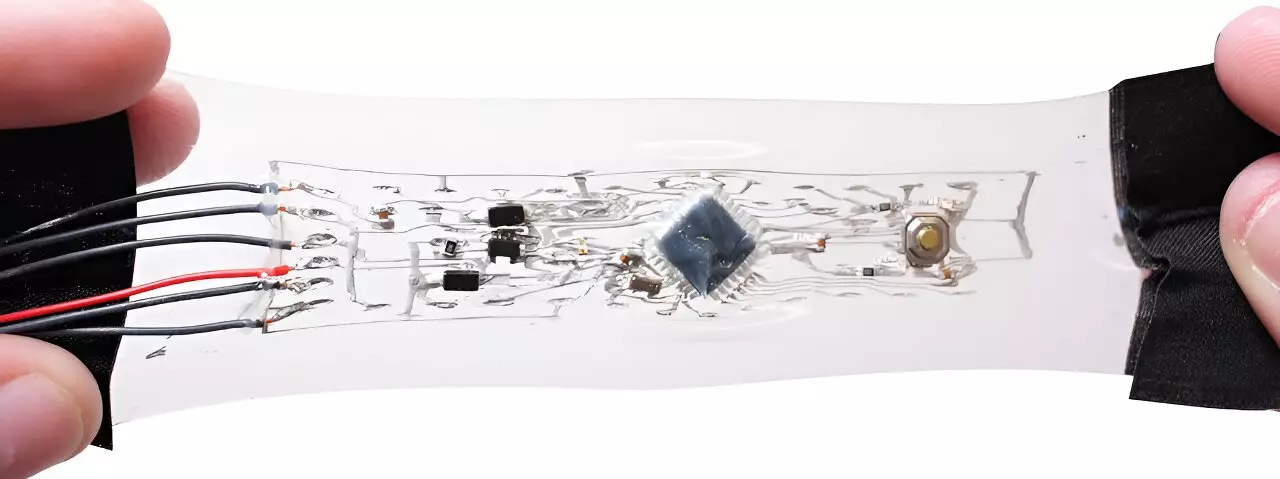In recent years, the convergence of robotics and flexible electronics has sparked a wave of innovation across various fields, including medicine, search-and-rescue operations, and rehabilitation. As technology increasingly integrates with our daily lives, the demand for devices that are both functional and adaptable has become more pronounced. Soft robots—machines with malleable structures—offer incredible potential, but the path to practical applications has been steeped in challenges, particularly concerning the integration of rigid components into these versatile systems. Researchers led by Professor Rebecca Kramer-Bottiglio have made significant strides in overcoming these barriers, creating a new class of stretchable electronics that promise to change how we approach soft robotics and wearable technology.
The Challenge of Rigid and Soft Integrations
A primary obstacle in developing effective soft robots is the interfacing of soft materials with rigid electronic components. Traditional circuitry is inflexible, making it ill-suited for incorporation into soft, dynamic structures. Consequently, many designs resort to external circuit boards, which hinder the functionality of the robots and diminish their potential use cases. This separation compromises the very essence of soft robotics, which seeks to emulate the adaptability and resilience of biological systems. By addressing this issue head-on, Kramer-Bottiglio’s team has opened new avenues for innovation, allowing for seamless and functional integrations of electronics within soft robotic systems.
The lab’s groundbreaking work with stretchable Arduinos—an open-source electronics platform widely used in robotics—marked a transformative leap. They created circuits capable of stretching three to four times their original size without compromising functionality. This impressive achievement exemplifies the team’s commitment to developing robust and reliable electronics in conjunction with their soft counterparts. As lead author Stephanie Woodman articulated, the project successfully navigated the usual limitations associated with stretchable electronics, paving the way for reliable multilayer circuits that can adapt to high-strain applications.
The researchers placed special emphasis on positioning complex circuitry at high-stress points within their devices. This approach not only underscored the robustness of their designs but also enabled greater freedom for future roboticists. By demonstrating that their circuitry could endure extensive stretching and deformation, they set a new standard for how electronic systems can be integrated within soft robotics.
One of the most enticing aspects of the research is its versatility. The ability to craft stretchable versions of various Arduino models, including the Pro Mini, Lilypad, and other sensory components, illustrates how adaptable the researchers’ methods are for different applications. Notably, they have simplified the construction of these circuits, removing the need for specialized expertise or equipment, thus democratizing access to advanced electronics and potentially inspiring a new wave of inventors and engineers in the field.
The practical applications of this stretchable technology are numerous. In the realm of rehabilitation, wearable devices that can assist those with injured limbs present a particularly exciting frontier. The researchers have already tested these concepts by embedding their stretchable electronics into devices placed on areas such as the elbow, demonstrating the technology’s effectiveness in accommodating the complex movements of the human body.
A pivotal component of the team’s success lies in their innovative manufacturing processes. They utilized gallium-based liquid metal, transforming it into a paste form to facilitate patternability and strong adhesion to various substrates. Through this method, they are able to create intricate electrical circuits that are not only effective but are also scalable and easier to replicate. Moreover, the open-source nature of their design and fabrication processes—shared via platforms like GitHub—promises to inspire further research and development in the domain, fostering a culture of collaboration within the engineering community.
The work conducted by Professor Kramer-Bottiglio’s research team signifies a monumental step toward a new era of soft robotics and wearable technology. As flexible electronics continue to advance, the applications for these innovations seem limitless—from rehabilitation aids to responsive robotic systems capable of seamlessly interacting with their environments. The journey toward integrating flexible electronics into soft robotics has been arduous, but the results are beginning to showcase an exciting future, ripe with possibilities that promise to enhance both human and robotic capacities. As researchers continue to innovate and refine their processes, we are on the brink of a technological revolution that could redefine how we interact with machines and assistive devices in our daily lives.


Leave a Reply